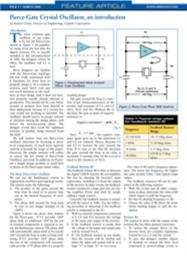Pierce-Gate Crystal Oscillator, an introduction
The most common gate oscillator in use today is by far the Pierce-Gate. Its popularity stems from the fact that the digital inverter, U1, is usually included in the microprocessor or ASIC the designer selects. In effect, the oscillator cell U1 is free!
This whitepaper will analyze how the Pierce-Gate oscillator functions by breaking it down to its components. However, the simple analysis will suffice to convey the key points of Pierce-Gate Oscillator operation. In addition, it will present a simple design problem to teach how to derive at the Pierce-gate initial values.
Download to find out more.
Read More
By submitting this form you agree to Crystek Corporation contacting you with marketing-related emails or by telephone. You may unsubscribe at any time. Crystek Corporation web sites and communications are subject to their Privacy Notice.
By requesting this resource you agree to our terms of use. All data is protected by our Privacy Notice. If you have any further questions please email dataprotection@techpublishhub.com
Related Categories: Capacitors, Components, Power


More resources from Crystek Corporation

Pierce-Gate Crystal Oscillator, an introduction
The most common gate oscillator in use today is by far the Pierce-Gate. Its popularity stems from the fact that the digital inverter, U1, is usuall...

Pocket-Size Signal Source
In the not too distance past, procuring a low phase noise 1 GHz source was very expensive, limiting it to only very high-end applications that coul...

Specifying a quartz crystal for a VCXO
A popular application for the voltage-controlled crystal oscillator is the forming of a phase-locked loop. Designing the VCXO for this application ...
